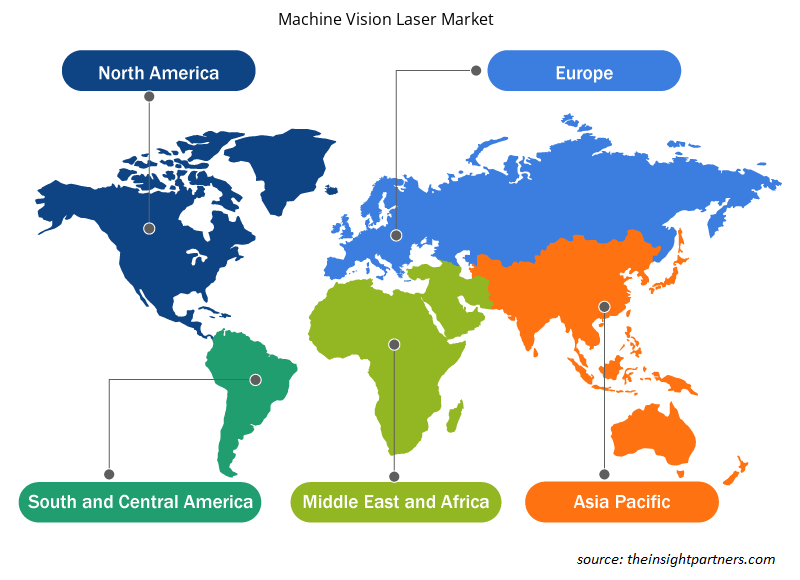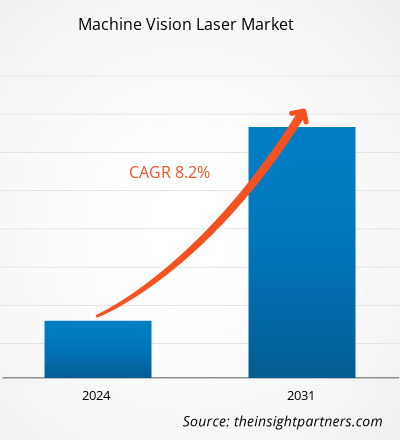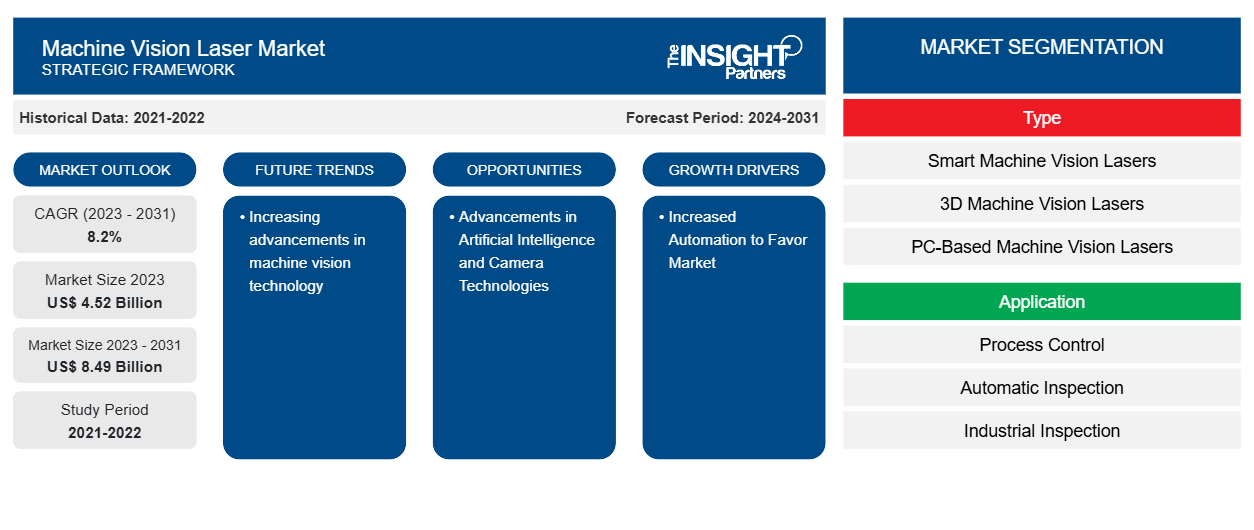من المتوقع أن ينمو حجم سوق الليزر العالمي للرؤية الآلية من 4.52 مليار دولار أمريكي في عام 2023 إلى 8.49 مليار دولار أمريكي بحلول عام 2031؛ ومن المتوقع أن يتوسع بمعدل نمو سنوي مركب قدره 8.2٪ من عام 2024 إلى عام 2031. ومن المرجح أن تظل التطورات المتزايدة في تكنولوجيا الرؤية الآلية أحد الاتجاهات الرئيسية لسوق الليزر للرؤية الآلية.
تحليل سوق الليزر للرؤية الآلية
من المتوقع أن يؤدي الطلب المتزايد على تحسين عمليات فحص الجودة والأتمتة عبر مختلف القطاعات الصناعية إلى تغذية نمو السوق.
نظرة عامة على سوق الليزر للرؤية الآلية
تستخدم أنظمة الليزر ذات الرؤية الآلية كاميرات الفيديو ومعالجة الإشارات الرقمية والتحويل من التناظرية إلى الرقمية للسماح لأجهزة الكمبيوتر بعرض وفحص وتقييم أداء العمل. تجمع هذه الأنظمة البيانات، والتي يتم إرسالها لاحقًا إلى جهاز كمبيوتر لمعالجتها وإنتاج الناتج المطلوب. الدقة والحساسية هما معلمتان أساسيتان في أنظمة الرؤية الآلية. تحدد الدقة قدرة النظام على التمييز بين الأشياء. في الوقت نفسه، تشير الحساسية إلى قدرة الآلة على تحديد الأشياء أو الإشارات الضعيفة في إعدادات الإضاءة المنخفضة أو عند الأطوال الموجية غير المرئية للعين البشرية. هذه الأنظمة بالغة الأهمية في إدارة بيئات العمل، بما في ذلك وظائف مثل التحكم في العمليات والتوجيه الآلي والتفتيش الآلي في التطبيقات الصناعية.
قم بتخصيص هذا التقرير ليناسب متطلباتك
ستحصل على تخصيص لأي تقرير - مجانًا - بما في ذلك أجزاء من هذا التقرير، أو تحليل على مستوى الدولة، وحزمة بيانات Excel، بالإضافة إلى الاستفادة من العروض والخصومات الرائعة للشركات الناشئة والجامعات
-
احصل على أهم اتجاهات السوق الرئيسية لهذا التقرير.ستتضمن هذه العينة المجانية تحليلاً للبيانات، بدءًا من اتجاهات السوق وحتى التقديرات والتوقعات.
محركات وفرص سوق الليزر للرؤية الآلية
زيادة الأتمتة لصالح السوق
لقد ازدادت شعبية الأتمتة في مجموعة متنوعة من القطاعات، مدفوعة بالرغبة في زيادة الكفاءة ومراقبة الجودة. هذا الاتجاه سائد بشكل خاص في التصنيع والخدمات اللوجستية. أدى نشر عمليات الأتمتة إلى زيادة الحاجة إلى أنظمة الرؤية الآلية، وخاصة التقنيات القائمة على الليزر، لتحسين هذه العمليات الآلية. يوفر استخدام الأتمتة في الإنتاج والخدمات اللوجستية العديد من الفوائد. تتمثل إحدى المزايا الرئيسية في التحكم الأفضل وتوحيد جودة المنتج. غالبًا ما تجري الأنظمة الآلية إجراءات الإنتاج بتباين أقل من العمال البشريين، مما يسمح بمزيد من التحكم في جودة المنتج.
التطورات في الذكاء الاصطناعي وتقنيات الكاميرا
لقد ساعدت التطورات في الذكاء الاصطناعي وتكنولوجيا الكاميرات بشكل كبير في نمو سوق الرؤية الآلية وتطورها. وقد أدت هذه التحسينات إلى تحسين قدرات أنظمة الرؤية الآلية، مما جعلها أكثر دقة وكفاءة في مجموعة متنوعة من التطبيقات. ومن أهم التطورات في مجال الرؤية الآلية الاستخدام المتزايد لتقنيات الذكاء الاصطناعي والتعلم العميق. حيث تمكن الخوارزميات وأساليب التعلم العميق أجهزة الكمبيوتر من التعلم من البيانات وتحسين أدائها بشكل مستقل، دون الحاجة إلى تدخل بشري. وقد أدى هذا إلى إنشاء أنظمة رؤية آلية معقدة بشكل متزايد يمكنها اكتشاف وتحليل الصور أو الأفلام بدقة وسرعة أعلى.
تقرير تحليل تجزئة سوق الليزر للرؤية الآلية
القطاعات الرئيسية التي ساهمت في اشتقاق تحليل سوق الليزر للرؤية الآلية من حيث النوع والتطبيق والمستخدم النهائي.
- وفقًا للنوع، يتم تقسيم السوق إلى ليزر الرؤية الآلية الذكية، وليزر الرؤية الآلية ثلاثية الأبعاد، وليزر الرؤية الآلية المستند إلى الكمبيوتر الشخصي. احتلت شريحة ليزر الرؤية الآلية الذكية حصة سوقية أكبر في عام 2023.
- بناءً على التطبيق، يتم تقسيم السوق إلى التحكم في العمليات والتفتيش التلقائي والتفتيش الصناعي وغيرها. احتل قطاع الليزر للتفتيش التلقائي حصة سوقية أكبر في عام 2023.
- بناءً على المستخدم النهائي، ينقسم السوق إلى السيارات والإلكترونيات وأشباه الموصلات والأغذية والمشروبات والأدوية والخدمات اللوجستية وغيرها. احتل قطاع السيارات حصة سوقية أكبر في عام 2023.
تحليل حصة سوق الليزر للرؤية الآلية حسب المنطقة الجغرافية
ينقسم النطاق الجغرافي لتقرير سوق الليزر للرؤية الآلية بشكل أساسي إلى خمس مناطق: أمريكا الشمالية، ومنطقة آسيا والمحيط الهادئ، وأوروبا، والشرق الأوسط وأفريقيا، وأمريكا الجنوبية/أمريكا الجنوبية والوسطى. سيطرت أمريكا الشمالية على سوق الليزر للرؤية الآلية في عام 2023. إن الطلب المتزايد على الأتمتة ودمج تقنيات التصوير المتقدمة في مجموعة واسعة من الصناعات يدفع سوق الليزر للرؤية الآلية في أمريكا الشمالية. علاوة على ذلك، من المتوقع أن يؤدي التركيز على التطورات التكنولوجية من قبل اللاعبين الرئيسيين في السوق إلى دفع نمو سوق الليزر للرؤية الآلية. تشمل هذه التطورات تطوير برامج مستقلة عن المنصة، وكاميرات ذكية، وأجهزة استشعار ثلاثية الأبعاد، ووحدات تحكم في الرؤية.
رؤى إقليمية حول سوق الليزر للرؤية الآلية
لقد قام المحللون في Insight Partners بشرح الاتجاهات والعوامل الإقليمية المؤثرة على سوق Machine Vision Laser طوال فترة التوقعات بشكل شامل. يناقش هذا القسم أيضًا قطاعات سوق Machine Vision Laser والجغرافيا في جميع أنحاء أمريكا الشمالية وأوروبا ومنطقة آسيا والمحيط الهادئ والشرق الأوسط وأفريقيا وأمريكا الجنوبية والوسطى.

- احصل على البيانات الإقليمية المحددة لسوق الليزر للرؤية الآلية
نطاق تقرير سوق الليزر للرؤية الآلية
| سمة التقرير | تفاصيل |
|---|---|
| حجم السوق في عام 2023 | 4.52 مليار دولار أمريكي |
| حجم السوق بحلول عام 2031 | 8.49 مليار دولار أمريكي |
| معدل النمو السنوي المركب العالمي (2023 - 2031) | 8.2% |
| البيانات التاريخية | 2021-2022 |
| فترة التنبؤ | 2024-2031 |
| القطاعات المغطاة |
حسب النوع
|
| المناطق والدول المغطاة |
أمريكا الشمالية
|
| قادة السوق وملفات تعريف الشركات الرئيسية |
|
كثافة اللاعبين في السوق: فهم تأثيرها على ديناميكيات الأعمال
يشهد سوق الليزر الآلي نموًا سريعًا، مدفوعًا بالطلب المتزايد من المستخدم النهائي بسبب عوامل مثل تفضيلات المستهلكين المتطورة والتقدم التكنولوجي والوعي الأكبر بفوائد المنتج. ومع ارتفاع الطلب، تعمل الشركات على توسيع عروضها والابتكار لتلبية احتياجات المستهلكين والاستفادة من الاتجاهات الناشئة، مما يؤدي إلى زيادة نمو السوق.
تشير كثافة اللاعبين في السوق إلى توزيع الشركات أو المؤسسات العاملة في سوق أو صناعة معينة. وهي تشير إلى عدد المنافسين (اللاعبين في السوق) الموجودين في مساحة سوق معينة نسبة إلى حجمها أو قيمتها السوقية الإجمالية.
الشركات الرئيسية العاملة في سوق الليزر للرؤية الآلية هي:
- شركة كافيتار المحدودة
- شركة كوجنكس
- شركة ليزر كومبونينتس المحدودة
- ليزركس
- شركة كينس
- بروفوتونيكس
إخلاء المسؤولية : الشركات المذكورة أعلاه ليست مرتبة بأي ترتيب معين.

- احصل على نظرة عامة على أهم اللاعبين الرئيسيين في سوق الليزر للرؤية الآلية
أخبار سوق الليزر للرؤية الآلية والتطورات الأخيرة
يتم تقييم سوق الليزر للرؤية الآلية من خلال جمع البيانات النوعية والكمية بعد البحث الأولي والثانوي، والذي يتضمن منشورات الشركات المهمة وبيانات الجمعيات وقواعد البيانات. فيما يلي قائمة بالتطورات في السوق:
- في أكتوبر 2023، قدمت شركة Keyence Corporation سلسلة VS، وهي خط جديد من أنظمة الرؤية الذكية للكاميرات. تم تصميم هذا النظام ليكون سهل الاستخدام ولا يتطلب لوحة تحكم أو برنامجًا للتحقق من عناوين IP والاتصالات. تم تصنيفه على أنه IP67 ويأتي مع العديد من الميزات التي تعزز وظائفه. تتضمن هذه الميزات مؤشر ليزر مدمجًا وأربع فتحات تثبيت لتكوينات التثبيت المرنة ودعم الطاقة عبر إيثرنت، مما يسمح بتشغيل كل من الكاميرا والضوء باستخدام كابل إيثرنت واحد.
(المصدر: Keyence Corporation، بيان صحفي، 2023)
تقرير سوق الليزر للرؤية الآلية والتغطية والنتائج
يوفر تقرير "حجم سوق الليزر للرؤية الآلية والتوقعات (2021-2031)" تحليلاً مفصلاً للسوق يغطي المجالات التالية:
- حجم السوق والتوقعات على المستويات العالمية والإقليمية والوطنية لجميع قطاعات السوق الرئيسية التي يغطيها النطاق
- ديناميكيات السوق مثل المحركات والقيود والفرص الرئيسية
- الاتجاهات المستقبلية الرئيسية
- تحليل مفصل لقوى PEST/Porter الخمس وSWOT
- تحليل السوق العالمي والإقليمي الذي يغطي اتجاهات السوق الرئيسية واللاعبين الرئيسيين واللوائح والتطورات الأخيرة في السوق
- تحليل المشهد الصناعي والمنافسة الذي يغطي تركيز السوق، وتحليل خريطة الحرارة، واللاعبين البارزين، والتطورات الأخيرة
- ملفات تعريف الشركة التفصيلية
- التحليل التاريخي (سنتان)، سنة الأساس، التوقعات (7 سنوات) مع معدل النمو السنوي المركب
- تحليل PEST و SWOT
- حجم السوق والقيمة / الحجم - عالمي، إقليمي، بلد
- الصناعة والمنافسة
- مجموعة بيانات إكسل
التقارير الحديثة
تقارير ذات صلة
شهادات العملاء
سبب الشراء
- اتخاذ قرارات مدروسة
- فهم ديناميكيات السوق
- تحليل المنافسة
- رؤى العملاء
- توقعات السوق
- تخفيف المخاطر
- التخطيط الاستراتيجي
- مبررات الاستثمار
- تحديد الأسواق الناشئة
- تحسين استراتيجيات التسويق
- تعزيز الكفاءة التشغيلية
- مواكبة التوجهات التنظيمية























 احصل على عينة مجانية ل - سوق ليزر الرؤية الآلية
احصل على عينة مجانية ل - سوق ليزر الرؤية الآلية